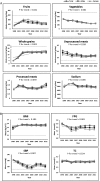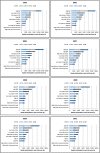Estimating change in cardiovascular disease and diabetes burdens due to dietary and metabolic factors in Korea 1998-2011: a comparative risk assessment analysis
- PMID: 28003293
- PMCID: PMC5223650
- DOI: 10.1136/bmjopen-2016-013283
Estimating change in cardiovascular disease and diabetes burdens due to dietary and metabolic factors in Korea 1998-2011: a comparative risk assessment analysis
Abstract
Objectives: Over the past 10 years, the burden of chronic diseases in Korea has increased. However, there are currently no quantitative estimates of how changes in diet and metabolic factors have contributed to these shifting burdens. This study aims to evaluate the contributions of dietary and metabolic risk factors to death from cardiometabolic diseases (CMDs) such as cardiovascular conditions, strokes and diabetes in Korea, and to estimate how these contributions have changed over the past 10 years (1998-2011).
Design and methods: We used data on 6 dietary and 4 metabolic risk factors by sex, age and year from the Korea National Health and Nutrition Examination Survey. The relative risks for the effects of the risk factors on CMD mortality were obtained from meta-analyses. The population-attributable fraction attributable to the risk factors was calculated by using a comparative risk assessment approach across sex and age strata (males and females, age groups 25-34, 35-44, 45-54, 55-64, 65-74 and 75+ years) from 1998 to 2011.
Results: The results showed that a suboptimal diet and high blood pressure were the main risk factors for CMD mortality in Korea. High blood pressure accounted for 127 096 (95% uncertainty interval (UI): 121 907 to 132 218) deaths from CMD. Among the individual dietary risk factors, a high intake of sodium (42 387 deaths; 95% UI: 42 387 to 65 094) and a low intake of fruit (50 244 deaths; 95% UI: 40 981 to 59 178) and whole grains (54 248 deaths; 95% UI: 47 020 to 61 343) were responsible for the highest number of CMD deaths in Korea.
Conclusions: Indicating the relative importance of risk factors in Korea, the results suggest that metabolic and dietary risk factors were major contributors to CMD mortality.
Keywords: burden of disease; cardiometabolic disease; cardiovascular disease; dietary risk; metabolic risk.
Published by the BMJ Publishing Group Limited. For permission to use (where not already granted under a licence) please go to http://www.bmj.com/company/products-services/rights-and-licensing/.
Conflict of interest statement
Conflicts of Interest: None declared.
Figures


Similar articles
-
Burdens of Cardiometabolic Diseases Attributable to Dietary and Metabolic Risks in Korean Adults 2012-2013.Yonsei Med J. 2017 May;58(3):540-551. doi: 10.3349/ymj.2017.58.3.540. Yonsei Med J. 2017. PMID: 28332359 Free PMC article.
-
The impact of dietary habits and metabolic risk factors on cardiovascular and diabetes mortality in countries of the Middle East and North Africa in 2010: a comparative risk assessment analysis.BMJ Open. 2015 May 20;5(5):e006385. doi: 10.1136/bmjopen-2014-006385. BMJ Open. 2015. PMID: 25995236 Free PMC article.
-
The Impact of Dietary and Metabolic Risk Factors on Cardiovascular Diseases and Type 2 Diabetes Mortality in Brazil.PLoS One. 2016 Mar 18;11(3):e0151503. doi: 10.1371/journal.pone.0151503. eCollection 2016. PLoS One. 2016. PMID: 26990765 Free PMC article.
-
Cardiovascular disease, chronic kidney disease, and diabetes mortality burden of cardiometabolic risk factors from 1980 to 2010: a comparative risk assessment.Lancet Diabetes Endocrinol. 2014 Aug;2(8):634-47. doi: 10.1016/S2213-8587(14)70102-0. Epub 2014 May 16. Lancet Diabetes Endocrinol. 2014. PMID: 24842598 Free PMC article. Review.
-
[Right diet can prevent cardiometabolic diseases].Lakartidningen. 2010 Sep 8-14;107(36):2077-82. Lakartidningen. 2010. PMID: 21043196 Review. Swedish. No abstract available.
Cited by
-
Sex- and Age-Specific Trends in Cardiovascular Health in Korea, 2007-2018.Korean Circ J. 2021 Nov;51(11):922-935. doi: 10.4070/kcj.2021.0211. Korean Circ J. 2021. PMID: 34719898 Free PMC article.
-
Joint Association of Sleep Onset Time and Sleep Duration With Cardiometabolic Health Outcome.J Am Heart Assoc. 2024 Jun 18;13(12):e034165. doi: 10.1161/JAHA.123.034165. Epub 2024 Jun 14. J Am Heart Assoc. 2024. PMID: 38874059 Free PMC article.
-
Association between food insecurity and metabolic syndrome in North West of Iran: Azar Cohort study.J Cardiovasc Thorac Res. 2019;11(3):196-202. doi: 10.15171/jcvtr.2019.33. Epub 2019 Aug 22. J Cardiovasc Thorac Res. 2019. PMID: 31579459 Free PMC article.
-
Incident type 2 diabetes attributable to suboptimal diet in 184 countries.Nat Med. 2023 Apr;29(4):982-995. doi: 10.1038/s41591-023-02278-8. Epub 2023 Apr 17. Nat Med. 2023. PMID: 37069363 Free PMC article.
-
The dietary transition and its association with cardiometabolic mortality among Chinese adults, 1982-2012: a cross-sectional population-based study.Lancet Diabetes Endocrinol. 2019 Jul;7(7):540-548. doi: 10.1016/S2213-8587(19)30152-4. Epub 2019 May 10. Lancet Diabetes Endocrinol. 2019. PMID: 31085143 Free PMC article.
References
-
- World Health Organization. Global status report on noncommunicable diseases 2014. Geneva, Switzerland: World Health Organization, 2014.
-
- Statistics Korea. Causes of Death Statistics in 2014. Daejeon, Korea: Statistics Korea, 2015.
-
- Lim SS, Vos T, Flaxman AD et al. . A comparative risk assessment of burden of disease and injury attributable to 67 risk factors and risk factor clusters in 21 regions, 1990–2010: a systematic analysis for the Global Burden of Disease Study 2010. Lancet 2012;380:2224–60. 10.1016/S0140-6736(12)61766-8 - DOI - PMC - PubMed
Publication types
MeSH terms
Substances
LinkOut - more resources
Full Text Sources
Other Literature Sources
Medical
Miscellaneous
